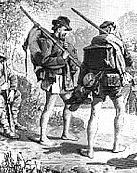Re: Altered Drawers
Hank,
You've helped highlight what I was concerned about when I first asked for documentation. Not having a source for a statement certainly undermines its reliability and is often reason enough to question its veracity. These secondary sources all say soldiers did this but none say how the came by that information. It is a big leap from saying some soldier somewhere may have done this to saying soldiers occasionally, frequently, regularly, always, ... did this. without the extra work to analyze the source of the information one might as well just accept the notion that any lie if told often enough (or put into print) is true. Fortunately with a little extra research and investigation one canmost often do better than that.
The footnote from The U.S. Army in the West 1870-1880 (great find by the way) states that the information comes from A Medical Report upon the clothing of the Soldiers of the US Army by Alfred A Woodhull, 1868. I didn't find a copy online so a trip to the library and submitting an Inter-library loan request may be in order. I did find an interesting summary of Woodhulls report online in Chapter 2 of The Army Medical Department 1865-1917 by Mary C. Gillett.
This whole discussion is a good example of how real research means going well beyond "I heard xxx rumor" or even "I read xxx supposition", and following the trail and investigating sources until one arrives at actual reliable facts. Despite all the great resources being added online today, research often requires one to actually do a little leg work and make some personal investment if they want to move from reenactorism to documented facts.
In asking for supporting documentation and looking for sources, I don't think anyone is concluding that no one ever did this, but rather what I'm reading, is people saying they've not heard or seen any documentation on this notion before and suggesting that we should investigate further to see where it takes us. We may or may not be able to definitively answer the questions about docked drawers, but along the way we are almost certain to learn something more than we knew at the beginning.
Hank,
You've helped highlight what I was concerned about when I first asked for documentation. Not having a source for a statement certainly undermines its reliability and is often reason enough to question its veracity. These secondary sources all say soldiers did this but none say how the came by that information. It is a big leap from saying some soldier somewhere may have done this to saying soldiers occasionally, frequently, regularly, always, ... did this. without the extra work to analyze the source of the information one might as well just accept the notion that any lie if told often enough (or put into print) is true. Fortunately with a little extra research and investigation one canmost often do better than that.
The footnote from The U.S. Army in the West 1870-1880 (great find by the way) states that the information comes from A Medical Report upon the clothing of the Soldiers of the US Army by Alfred A Woodhull, 1868. I didn't find a copy online so a trip to the library and submitting an Inter-library loan request may be in order. I did find an interesting summary of Woodhulls report online in Chapter 2 of The Army Medical Department 1865-1917 by Mary C. Gillett.
This whole discussion is a good example of how real research means going well beyond "I heard xxx rumor" or even "I read xxx supposition", and following the trail and investigating sources until one arrives at actual reliable facts. Despite all the great resources being added online today, research often requires one to actually do a little leg work and make some personal investment if they want to move from reenactorism to documented facts.
Originally posted by Hank Trent
View Post






Comment